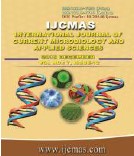


 National Academy of Agricultural Sciences (NAAS)
National Academy of Agricultural Sciences (NAAS)

|
PRINT ISSN : 2319-7692
Online ISSN : 2319-7706 Issues : 12 per year Publisher : Excellent Publishers Email : editorijcmas@gmail.com / submit@ijcmas.com Editor-in-chief: Dr.M.Prakash Index Copernicus ICV 2018: 95.39 NAAS RATING 2020: 5.38 |
Efforts are in progress to conserve critically endangered Gyps spp. vultures by identifying and removing the vulture-unsafe drugs from the food chain. Several drugs namely diclofenac, aceclofenac, ketoprofen and nimesulide are found to cause hyperuricemia and fatal nephrotoxicity in Gyps vultures. Research on development of an in vitro model for screening drugs in practice and the new molecules for their hyperuricemic potential can facilitate the conservation efforts. Multi drug resistant protein 4 (MRP4/ABCC4) is an efflux transporter on the luminal side of proximal renal tubular membrane that plays key role in urate as well as drug transport. In the present study, we report development and use of Gyps himalayensis MRP4 specific multiple antigenic peptide (MAP). Sequences of linear peptide and N terminal immunodominant region of Gyps himalayensis MRP4 was predicited in silico. Tetrameric MAP was synthesized in solid phase synthesis (SPPS) using Wang resin and employed for immunization of rabbit for obtaining polyclonal serum. N terminal region (1-737 amino acids) of vulture MRP4 predicted to contain immunodominant epitopes was expressed in E. coli BL21 cells and purified in Ni-NTA affinity chromatography. The ï¾24 kDa purified protein could be detected in immunoblots using anti-MAP serum indicating its potential in detection of MRP4 expression. This hyperimmune serum can be exploited for its use in detection of MRP4 expression in avian renal tubular cells or MRP4 expressing cells before their use for screening drugs for their role in urate transport.
 |
 |
 |
 |
 |